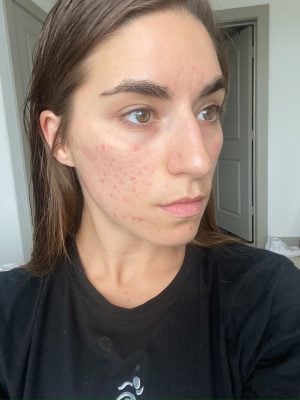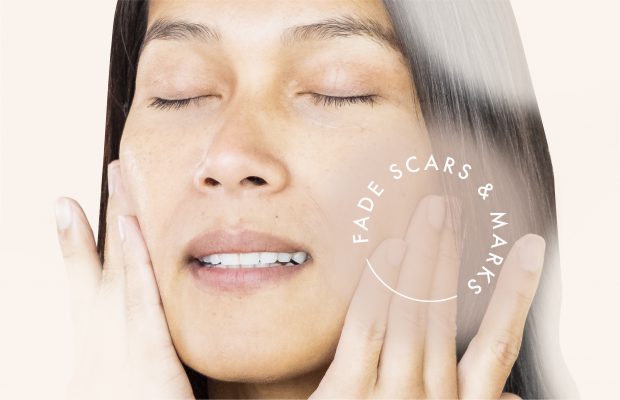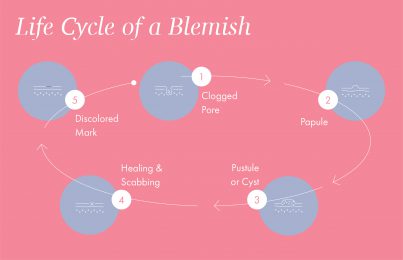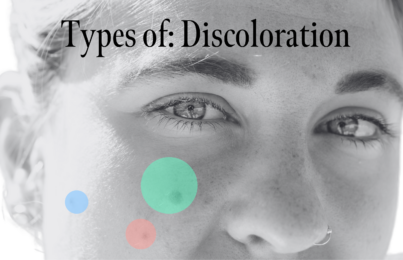Updated 10/10/22. If you experience breakouts, you’ve almost certainly also experienced the brown, purple, or red marks that are leftover long after they’re gone. I truly believe these are worse than the breakouts themselves, simply because a breakout only lasts for five to seven days, whereas the post-breakout mark can last up to eight months! In this post, I’ll share my expert tips for fading these marks fast, so your skin can be more clear and even-toned.
- What Causes Post-Breakout Marks?
- What Determines the Severity of a Post-Breakout Mark?
- Why Did I Get a Post-Breakout Mark Even Though I Barely Touched It?
- What Can I Do to Fade My Post-Breakout Marks?
- What If a Blemish Left an Indent in My Skin?
- Post-Inflammatory Hyperpigmentation & Post-Inflammatory Erythema
- Can I Prevent Post-Breakout Marks?
What Causes Post-Breakout Marks?
These marks are the result of inflammation within the dermis (the middle layer of the skin). It triggers the skin to produce pigment cells, called melanocytes, which are a natural response to trauma. In addition, capillaries become dilated (or even break) during the blemish cycle, which brings about extra redness. To avoid these things, a blemish must be properly cared for.
What Determines the Severity of a Post-Breakout Mark?
Have you noticed that some blemishes seem to leave more severe marks than others? There are different factors that affect this.

1. Skin Tone
People who have deeper skin tones are more likely to experience this hyperpigmentation due to the natural melanin content in the skin.
2. Type of Blemish
If the blemish broke through the surface of the skin in the way papules, pustules, and whiteheads do, then you’ll be more likely to develop a mark. If the blemish formed deep within the skin and never broke the skin’s surface (such as a cyst), you’ll be less likely to develop a mark.
3. Duration of Blemish
Every type of blemish seems to have a life of its own, and some will last longer than others based on their size and location. Generally speaking, the longer a blemish lasts, the more likely it is to develop a mark.
4. How the Blemish Was Cared For
Every move you make with a blemish will greatly affect the mark it leaves behind. The more you pick it, over-dry it, or mess with it, the more likely a dark mark will appear once it’s gone. Trust me on this. Instead of constantly messing with a blemish, turn to skincare products with blemish-fighting ingredients, such as the Zit Care Kit. I specifically formulated it to address blemishes at every stage. It includes all the necessary instructions and tools you need to make a blemish go away fast.
Why Did I Get a Post-Breakout Mark Even Though I Barely Touched It?
Even if you didn’t touch it, a blemish can still leave a mark. If it was a papule, pustule, or whitehead, and it broke through the skin’s surface, it could have automatically triggered a melanin response.
If it was a cyst, and it never broke through, the bump underneath could have stretched the surrounding tissue, which also could have triggered a melanin response. The bottom line is that you can still develop a mark even if you don’t touch the breakout.
What Can I Do to Fade My Post-Breakout Marks?
Once a blemish is gone and you’re left with a red, brown, or purple mark, it’s time to focus on doing three things.
1. Exfoliate to Lift and Dissolve Discoloration
Using a gentle chemical exfoliant (like the BHA Clarifying Serum) can loosen discolored cells from the skin’s surface. Using a gentle facial scrub (like the Triple Berry Smoothing Scrub) twice a week can lift those loosened cells off the skin. This can reveal even-toned skin underneath. This two-step exfoliation method is the key to fading all kinds of hyperpigmentation.
You can also use the Post-Breakout Fading Gel, which is a spot treatment formulated specifically for this skin concern. I recommend that you apply your regular exfoliating acid serum in the evening and follow with moisturizer. Then, wipe the post-breakout mark with a damp cotton swab to remove the previously applied products. Follow up with a thin layer of the Post-Breakout Fading Gel. (While exfoliating acid serums do help fade post-breakout marks, this gel will work better since it’s a higher concentration of acids.)
It’s recommended to use this gel no more than four nights a week. A post-breakout mark is very delicate and you don’t want to cause irritation. If redness or irritation occurs, cut back on usage or discontinue completely.
2. Use a Vitamin C Serum to Suppress Melanin Activity
When you’re exfoliating the skin and removing dry, discolored surface cells, a product with brightening ingredients can absorb deeper within the mark and help suppress melanin activity. Many forms of vitamin C (particularly magnesium ascorbyl phosphate) work to gently calm redness and fade post-breakout marks. This can also help with post-inflammatory erythema (PIE), which I’ll discuss in a little bit.
3. Use Sunscreen to Prevent UV Light From Keeping Pigment Cells Active
This is really important and something that people too often ignore. UV light (which you’re exposed to even on cloudy days) will naturally activate melanin cells. Since post-breakout marks are an indication of over-active melanin cells, UV light will only make them more noticeable.
You absolutely MUST use sunscreen every single day. It’s hands down the most effective product for fading post-breakout marks, since it gives pigment cells an opportunity to calm down, thereby fading dark marks. If you’re blemish-prone, it’s important to use one that is lightweight, like Weightless Protection SPF 30. After all, the last thing you want is for your sunscreen to cause more breakouts, right?
What If a Blemish Left an Indent in My Skin?
Generally speaking, it’s deep cystic blemishes that will have this effect on skin tissue, causing keloid, hypertrophic, or atrophic scars. The atrophic ones are most commonly associated with blemishes. They happen when damage occurred deep within the skin, causing an indent to form. Sometimes they can be temporary. Other times they can last a lifetime. Read how to smooth indented scars, then, find out if micro needling can help!
Post-Inflammatory Hyperpigmentation & Post-Inflammatory Erythema
Most people will have a mix of both but there is a distinct difference.
Post-Inflammatory Hyperpigmentation (PIH)
This appears as the red, brown, or purple marks that I’ve been discussing in this post. It’s directly related to melanin activity that creates unwanted pigment in the skin. This can occur for anyone who gets blemishes. It usually lasts longer for medium-to-deep skin tones. All of the tips in this post will help with this condition.
Post-Inflammatory Erythema (PIE)
This is redness and swelling that are related to vascular activity. When a blemish occurs, the skin will initiate a healing response—small proteins called cytokines will trigger inflammation and white blood cells will come to fight the infection. These white blood cells can’t fit into smaller capillaries so they dilate and potentially break. This leads to vascular damage that causes redness. You’ll find this occurs most often with fair skin tones. To help fade redness faster, apply a vitamin C serum. You can also consult a dermatologist about vascular pulsed dye lasers.
To help keep capillaries strong, I recommend getting plenty of bioflavonoids in your diet. You can find these in citrus fruits. Read more about preventing broken capillaries.
Can I Prevent Post-Breakout Marks?
The best way to prevent post-breakout marks is to prevent breakouts in the first place. So, ideally, you would never break out again, but this simply isn’t realistic. It is possible to minimize breakouts, though, and for that, I recommend taking the Skin Type Quiz to fully understand your skin and what it needs. At the end of the quiz, you’ll get personalized product recommendations to help you address breakouts and post-breakout marks.
As for when a breakout appears, make sure you know how to get rid of a blemish fast. You might not always have control over when and where blemishes appear, but you DO have control over what happens once they show up.
Next, check out my complete guide to clearing clogged pores once and for all!
Celebrity Esthetician & Skincare Expert
As an esthetician trained in cosmetic chemistry, Renée Rouleau has spent 35 years researching skin, educating her audience, and building an award-winning line of products. Her hands-on experience as an esthetician and trusted skin care expert has created a real-world solution — products that are formulated for nine different types of skin so your face will get exactly what it needs to look and feel its best. Trusted by celebrities, editors, bloggers, and skincare obsessives around the globe, her vast real-world knowledge and constant research are why Marie Claire calls her “the most passionate skin practitioner we know.”




Comments:
Informative article!
Acne scars are of different types and treating each type needs varied treatment procedures. We can use treatments such as Skin Boosters, PRP and Pixel Perfect. A trained esthetician can give proper advice on this issue.
Posted By: Limsy Dsouza |
Thanks for posting, this was informative!
Posted By: Heng Wee |
Try dermalmd scar serum for your scar care, This serum works really well. My daughter has acne and she had a habit of picking at it which caused scars and I can see a noticeable difference in her skin and it’s been less than a month! My advise is to use it 2 times a day after you wash the scared area.
Posted By: Kara |
I find that exfoliating always make my skin break out more? Any advise?
Posted By: Mandy |
Do you recommend using a Dermaroller for acne scarring?
Posted By: Samantha |
I don’t have personal experience using dermaroller but I have not seen where it has improved scars from acne effectively.
Posted By: Renée Rouleau |